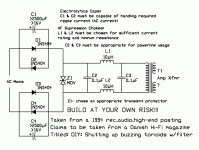First there's the one that's attached to this post (first half of schematic), with the disadvantage that you need a lot of capacitance if you are drawing appreciable current from the mains, or it doesn't work very well.
But I don't understand the following two.
First:
http://www.diyaudio.com/forums/attachment.php?s=&postid=328821
Why are the two capacitors in parallel? In the case of DC, one would be reverse biased and the aluminum oxide dielectric will electrolyze. The other one keeps working, but what happens when DC offset changes sign (say plugged in somewhere else)? Then you end up with two ruined caps.
Second:
http://www.psaudio.com/products/images/306_1.jpg
How can this work with such small capacitors? All that the maker said in the previous thread where this was mentioned is:
But I don't understand the following two.
First:
http://www.diyaudio.com/forums/attachment.php?s=&postid=328821
Why are the two capacitors in parallel? In the case of DC, one would be reverse biased and the aluminum oxide dielectric will electrolyze. The other one keeps working, but what happens when DC offset changes sign (say plugged in somewhere else)? Then you end up with two ruined caps.
Second:
http://www.psaudio.com/products/images/306_1.jpg
How can this work with such small capacitors? All that the maker said in the previous thread where this was mentioned is:
So the small blue caps appear to be just there to take care of diode switching ringing. But what about the other ones? The use of XY rated caps suggest they see at least a good part of the mains AC voltage, so this seems to be a different type of design than the attached one. Also, it was said there are 8 caps, whereas I can only see 7 in the picture.You must use the right caps. They need to be AC rated X and Y caps so you don't start any fires. They are pretty expensive (relatively). The caps are aranged such that at AC zero cross, where the diodes aren't allowing any current to flow, the caps couple the AC line to the load. The other caps clean up the sharp transition of when the diodes conduct.
Attachments
By that logic there's no point in having them antiparallel. Yet the schematic explicitly shows they are not facing the same way. Indeed, you don't even need two capacitors, just one. So that doesn't fit. In any case, I think any DC over time will electrolyze the dielectric. To make a non-polar electrolytic you need to put two in series, facing opposite ways.
- Status
- This old topic is closed. If you want to reopen this topic, contact a moderator using the "Report Post" button.
